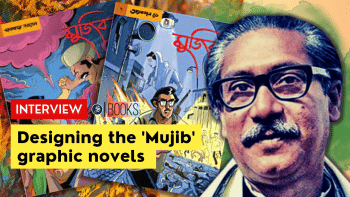Dhaka Comics' 'Protibastob' is a big step forward in our comic book industry

When I saw the first public announcement of Protibastob (Dhaka Comics, 2022) on social media, I knew right away that this was going to be something special. Immediately I did two things: I pre-ordered two copies, and I messaged the Editor of Daily Star Books to call dibs on reviewing it. Sarah Anjum Bari gracefully agreed.
I got the package from Dhaka Comics a few weeks later. I unwrapped it carefully and found, to my pleasant surprise, that it wasn't only the book in the pack, with the title and cover art designed on it—there was also a sticker set of fascinating looking characters and a poster of the book as well.
The dust jacket on the book depicts a post-apocalyptic world where nature has overtaken an urban city due to human neglect—with the sun on the horizon, a girl is sitting on a thick vine wrapped around the remnants of what appears to be a tall building. Near her, a cat is sitting atop the hood of a rickshaw without wheels. While the artwork fascinated me, I couldn't help notice that the title, Protibastob Comics Shongkolon 2022, was not well aligned. I took off the dust jacket and found that the hardcover of the book was in black, and the name in silver. Below it was a silver silhouette of the 'futuristic Subodh' from the sticker set. I couldn't wait to dive in.
Protibastob is perhaps the first of its kind in the country—the biggest anthology of original comic books focusing on young and super-talented artists. The 22 stories are written by popular, contemporary writers with big names such as Muhammed Zafar Iqbal, Ahsan Habib, and Mehedi Haque. Their stories are fun to read, nine of which are written by the artists themselves. Genre-wise, they are pleasantly diverse, including sci-fi, horror, adventure, fantasy, and so on, and most of them, regardless of genre, brought unexpected turns at the end that I could not predict. A few that I particularly enjoyed were 'Eka', 'Quarantined', 'Daini', 'Nishongota', and 'Kissa'.
The collection has a few feel-good stories which young children would really enjoy—one called "Summer", which is about a cat not feeling loved by her owners; "Harano Ebong Pawa", about a little girl always losing her things mysteriously; "Krakra", about a young crow being ridiculed for his 'sweet' voice; and a few others. However, given that a lot of the other stories have dark undertones and violence in them, including serial killing and body horror elements, and sci-fi and horror stories where the monsters have the last laugh—I would not recommend this book for readers below their teen years.
Each of the 22 artists in the book shines bright in their own unique colours (pun not intended, with 19 of the stories drawn in black and white). Intricate background details of futuristic worlds, manga-like look and feel, well-drawn body horror elements, minimalist art—this book has got it all!
Jumping from one story to another with a completely different art-style is something that I immensely enjoyed because there was always something new. I found the dynamic and 'fast-paced' art of "Chhut'' delightful, as well as the immaculately detailed world of a post-apocalyptic time in "Eka". The simplistic art of "Quarantined" and the innovative panelling of "Oshombhob Chur" caught my attention as well. This book can serve as a great case study for up-and-coming comic book artists in the country.
As bonus content, there is a very well-researched and detailed article on the history and evolution of Bangla comics. Two insightful interviews are also included. One of Sankha Banerjee, the artist of The Mahabharata graphic novel, whose work I have always heard about but never got the opportunity to experience—which will soon change, thanks to the inclusion of his interview. The other is of Dave Gibbons, the artist of Watchmen, one of the best graphic novels ever created.
In his interview, Gibbons offers a glimpse of the differences between the US and UK comic book industry—how in the UK, comic books were mostly black and white, while the advent of colourful comics in America was compared to colour television. Furthermore, I always knew (like many others) that the writer of Watchmen, Alan Moore, did not like the film adaptation of the graphic novel—which, I found out, wasn't entirely accurate.
Protibastob is a big step forward in the evolution of the Bangladeshi comic book industry and I dearly hope that Dhaka Comics makes this a yearly publication where popular writers join forces with talented young artists to create something that is truly unique, fascinating, and celebratory of this visually engaging mode of story-telling.
Read an excerpt of Shankha Banerjee's interview tomorrow on The Daily Star website and on Daily Star Books' Facebook, Instagram and Twitter pages.
Kaisar Kabir is a pop-culture enthusiast and a former radio show host currently earning dough in the content industry.

 For all latest news, follow The Daily Star's Google News channel.
For all latest news, follow The Daily Star's Google News channel. 











Comments